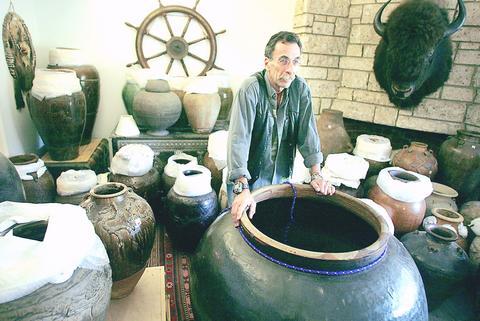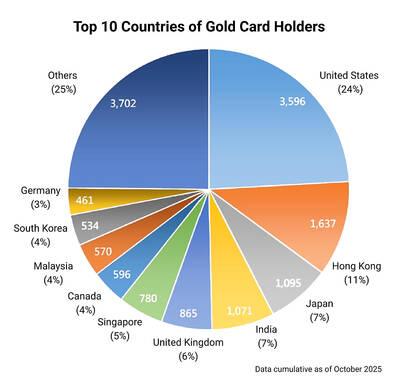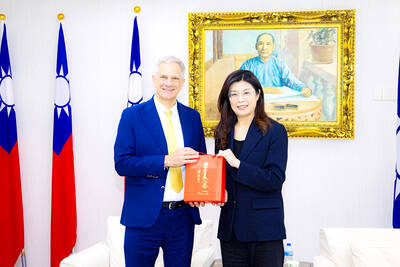Emory Kristof couldn't believe his eyes. Crammed into a nondescript house in suburban Los Angeles were roughly 10,000 pieces of Chinese porcelain and pottery, some up to 2,000 years old, so densely packed that any movement threatened to send them crashing to the floor. Some were still encrusted with coral, evidence of their hidden life for centuries under the sea.
"It blew my socks off," Kristof, an undersea explorer and photographer, said. "It was absolutely incredible, the mother of all treasure."

PHOTO: NY TIMES
It is now also the subject of an emerging dispute between the entrepreneur who assembled the trove, working quietly in the Philippines while employing hundreds of locals to retrieve the old riches, and archeologists who say he is plundering the world's artistic patrimony to line his own pockets.
The entrepreneur is Phil Greco, a former New Yorker who became interested in Asian culture while serving in the Vietnam War. He lived and worked in the Philippines for more than a decade salvaging old Chinese shipwrecks. From his home in the Sherman Oaks section of Los Angeles, Greco is shipping his discoveries back East, where they are to be put up for auction.
Some 7,000 of the artifacts have so far reached a warehouse in South Kearny, New Jersey, across the Hudson River from New York City. Some 3,000 are en route. They will be sold this fall by Guernsey's, an auction house on Manhattan's East Side.
Art experts who have seen the collection call it impressive.
"It was mind boggling," said Arlan Ettinger, president of Guernsey's, who visited Greco's Los Angeles home two months ago to assess the assembled pottery.
But Donny Hamilton, president of the Institute of Nautical Archaeology at Texas A&M University, a top preserver of old shipwrecks and their artifacts, said archeologists worry when private salvors excavate potentially important undersea sites. They "recover just what has a market value," Hamilton said.
"The other material is ignored or left behind, so you only learn about the ceramic trade but nothing about the people on board, what they were eating, their armaments, the games they were playing," he added.
The Chinese and Asian ceramics are insured for US$20 million, Greco said, though Ettinger says the appraisal process is unfinished and the ultimate value of the collection unknown.
Ettinger said the pieces were 500 to 2,000 years old, many from the Ming and Song Dynasties, and many in remarkable condition, from the smallest powder jars to the largest vases up to 1.5m tall.
He said the colorful collection included blue and white Ming porcelain, and other pottery and porcelain in earthen tones, browns and burnt oranges and a spectrum of greens, from pale to intense.
Photographs of some are posted on the auction house's Web site, www.guernseys.com, under current auctions.
Victoria Johnson-Campbell, chief of Aurora Galleries International, in Bell Canyon, California, said she had seen the collection at Greco's home and found it extraordinary. "It's a stunning array," Johnson-Campbell said.
But Hamilton, who viewed the collection on the auction house Web site, said he was disturbed by the excavation. "Here we have only a small fraction of what we could have learned from the sites if they had been properly excavated and documented," Hamilton said.
Greco, a former Marine who earned two purple hearts in Vietnam, bristled at such criticism. He said archeologists did not have the money or skill to save such rich history from the ravages of the sea.
"They say it's outrageous that I'm pillaging all these national treasures," Greco said. "But if you're archeologically correct you could never ever bring this kind of show to the world. It's impossible. It's too much. It's a bridge of 2,000 years of Chinese art and history."
Greco says his story is one of hard work and pennypinching entrepreneurism that succeeded because he developed close personal bonds with Filipinos living in remote villages near the islands of Panay, Mindanao and Busuanga.
"I stayed with the natives, the
fishermen," Greco said. "And they led us to the sites."
The shipwrecks, he said, are embedded in reefs off Philippine islands in the South China Sea. "We have 16 sites we've been working in the last six or seven years," Greco said. Three sites have been highly productive, he added, including one his divers are still swimming down to and recovering artifacts from.
The shipwrecks lie at depths as great as 85m, Greco said, which is beyond the range of most sport divers. He said his team used no air tanks but rather weights and lines and hoses that bring air down to men working in the bottom gloom. Some of the divers swam with wooden paddles strapped to their feet, rather than fins. "Tanks are for tourists," Greco said.
Greco, whose company, Stallion Recoveries, is based in Hong Kong, said the lost ships were either going to Chinese trading posts in the Philippines or were on their way to Indonesia, to the south. Experts say the South China Sea abounds in wrecks lost to storms, piracy and ineptitude.
Greco said he always kept a low profile for his operation, even while getting the proper permits from the National Museum of the Philippines and other Philippine authorities. "We never told anybody what we were doing," he said.
He added that he was apprehensive about making his finds public because that could make working more difficult. "In the Philippines and Asia, depending on where you are, they think of them as pots and pans," he said of the lost treasures. "Once they see it has value, and somebody's interested, it's going to be a lot different working over there."
Greco said he planned to plow some of his expected profits back to his crew chiefs in the Philippines.
"I told them I would make each of them a millionaire in their own currency," Greco said. "And I will honor that."

Seven hundred job applications. One interview. Marco Mascaro arrived in Taiwan last year with a PhD in engineering physics and years of experience at a European research center. He thought his Gold Card would guarantee him a foothold in Taiwan’s job market. “It’s marketed as if Taiwan really needs you,” the 33-year-old Italian says. “The reality is that companies here don’t really need us.” The Employment Gold Card was designed to fix Taiwan’s labor shortage by offering foreign professionals a combined resident visa and open work permit valid for three years. But for many, like Mascaro, the welcome mat ends at the door. A

Last week gave us the droll little comedy of People’s Republic of China’s (PRC) consul general in Osaka posting a threat on X in response to Japanese Prime Minister Sanae Takaichi saying to the Diet that a Chinese attack on Taiwan may be an “existential threat” to Japan. That would allow Japanese Self Defence Forces to respond militarily. The PRC representative then said that if a “filthy neck sticks itself in uninvited, we will cut it off without a moment’s hesitation. Are you prepared for that?” This was widely, and probably deliberately, construed as a threat to behead Takaichi, though it

If China attacks, will Taiwanese be willing to fight? Analysts of certain types obsess over questions like this, especially military analysts and those with an ax to grind as to whether Taiwan is worth defending, or should be cut loose to appease Beijing. Fellow columnist Michael Turton in “Notes from Central Taiwan: Willing to fight for the homeland” (Nov. 6, page 12) provides a superb analysis of this topic, how it is used and manipulated to political ends and what the underlying data shows. The problem is that most analysis is centered around polling data, which as Turton observes, “many of these

Since Cheng Li-wun (鄭麗文) was elected Chinese Nationalist Party (KMT) chair on Oct. 18, she has become a polarizing figure. Her supporters see her as a firebrand critic of the ruling Democratic Progressive Party (DPP), while others, including some in her own party, have charged that she is Chinese President Xi Jinping’s (習近平) preferred candidate and that her election was possibly supported by the Chinese Communist Party’s (CPP) unit for political warfare and international influence, the “united front.” Indeed, Xi quickly congratulated Cheng upon her election. The 55-year-old former lawmaker and ex-talk show host, who was sworn in on Nov.